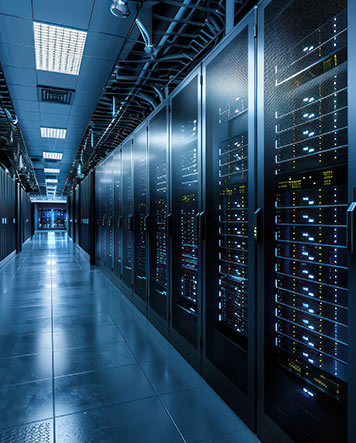PLCs and DCSs in Data Centers: Ensuring Reliability and Efficiency in the Digital Backbone
Introduction
Data centers are the critical infrastructure that power the modern digital world, housing the servers, storage, and networking equipment that support cloud computing, online services, and data-intensive applications. Uptime, reliability, and energy efficiency are paramount concerns in data center operations. While Building Management Systems (BMS) are commonly associated with data center infrastructure, Programmable Logic Controllers (PLCs) and Distributed Control Systems (DCSs) play increasingly vital, and often overlapping, roles in managing and optimizing the complex power, cooling, and environmental systems within these facilities. This article explores the specific applications of PLCs and DCSs in data centers.
PLC Applications in Data Centers
PLCs are used for discrete control and monitoring tasks, managing individual pieces of equipment and ensuring rapid response to changing conditions:
- Power Distribution Units (PDUs): PLCs control and monitor PDUs, which distribute power to server racks. This includes:
- Circuit Breaker Monitoring: Monitoring the status of circuit breakers and providing alerts for trips.
- Power Metering: Measuring power consumption at the rack level.
- Remote Switching: Enabling remote switching of power outlets.
- Uninterruptible Power Supplies (UPS): PLCs control and monitor UPS systems, which provide backup power in case of a utility outage. This includes:
- Battery Monitoring: Monitoring battery voltage, current, and temperature.
- Bypass Switch Control: Controlling the transfer switch between utility power and UPS power.
- Inverter Control: Monitoring and controlling the inverter, which converts DC power from the batteries to AC power.
- Automatic Transfer Switches (ATS): PLCs control ATSs, which automatically switch between utility power and generator power.
- Generator Control: PLCs manage the startup, shutdown, and synchronization of generators.
- Computer Room Air Handlers (CRAHs) / Computer Room Air Conditioners (CRACs): While often part of a larger BMS or DCS, PLCs can control individual CRAH/CRAC units, managing:
- Fan Speed Control: Adjusting fan speed based on cooling demand.
- Temperature and Humidity Control: Monitoring and controlling temperature and humidity within the unit.
- Filter Monitoring: Monitoring the status of air filters.
- Chillers (Local Control): PLCs can provide local control for individual chillers, managing pumps, valves, and temperature setpoints.
- Leak Detection Systems: PLCs monitor leak detection sensors and provide alerts for water or refrigerant leaks.
DCS Applications in Data Centers
DCSs are employed for overall system management, continuous monitoring, and optimization of the data center’s critical infrastructure:
- Chiller Plant Management: The DCS oversees the entire chiller plant, coordinating multiple chillers, pumps, cooling towers, and associated equipment. This involves:
- Chiller Sequencing: Optimizing the operation of multiple chillers to meet cooling demand efficiently.
- Pump Control: Controlling the speed and operation of pumps to circulate chilled water.
- Cooling Tower Control: Managing the operation of cooling towers to dissipate heat.
- Temperature Optimization: Maintaining the optimal chilled water supply temperature.
- Power Monitoring and Management: The DCS provides a comprehensive view of power consumption throughout the data center, including:
- Power Usage Effectiveness (PUE) Monitoring: Calculating and tracking PUE, a key metric for data center energy efficiency.
- Load Balancing: Distributing power loads evenly across different power sources and circuits.
- Capacity Planning: Monitoring power capacity and identifying potential bottlenecks.
- Environmental Monitoring: The DCS monitors temperature, humidity, airflow, and other environmental parameters throughout the data center.
- Data Center Infrastructure Management (DCIM): DCSs often integrate with DCIM software, providing a centralized platform for monitoring, managing, and optimizing all aspects of the data center infrastructure.
- Alarm Management: The DCS provides sophisticated alarm management capabilities to alert operators to abnormal conditions and potential problems.
- Predictive Maintenance: The DCS can use historical data and trend analysis to predict potential equipment failures and schedule maintenance proactively.
Hybrid Systems and Integration (BMS, PLCs, and DCSs)
Data centers often utilize a hybrid approach, integrating BMS, PLCs, and DCSs:
- BMS for Overall Facility Management: The BMS typically handles overall building management functions, such as lighting, security, and fire suppression.
- PLC for Local Control: PLCs manage individual pieces of equipment and provide fast, localized control.
- DCS for Critical Systems Management: The DCS oversees the critical power and cooling systems, ensuring optimal performance and reliability.
- Data Exchange and Communication: The BMS, PLCs, and DCSs communicate with each other, exchanging data and coordinating operations. This is crucial for a unified view of the entire facility.
- DCIM Integration: All three systems can be integrated with DCIM software, providing a centralized platform for monitoring, management, and optimization.
Benefits of PLCs and DCSs in Data Centers
- Increased Reliability and Uptime: Automation reduces the risk of human error and ensures consistent operation of critical systems, minimizing downtime.
- Improved Energy Efficiency: DCSs help to optimize power and cooling systems, reducing energy consumption and operating costs.
- Enhanced Security: Automated systems can improve security by monitoring access control, intrusion detection, and other security measures.
- Reduced Operating Costs: Automation reduces labor costs, energy consumption, and maintenance expenses.
- Scalability: PLC and DCS systems can be easily scaled to accommodate growing data center capacity.
- Data-Driven Decision Making: Real-time data from PLCs and DCSs provides valuable insights for capacity planning, predictive maintenance, and continuous improvement.
- Faster Response to Issues: PLCs provide rapid response to changing conditions, while DCSs offer comprehensive alarm management.
Conclusion
PLCs and DCSs are playing an increasingly important role in modern data centers, providing the automation, control, and integration capabilities needed to ensure reliable, efficient, and secure operations. While BMS systems are common, the need for precise control and optimization of power and cooling systems is driving the adoption of PLCs and DCSs. The trend towards hybrid systems and integration with DCIM software will continue to enhance the performance and efficiency of data centers, supporting the ever-growing demands of the digital world. The distinction between BMS, PLC, and DCS roles is becoming increasingly blurred, with a focus on integrated solutions.
 中文版
中文版






